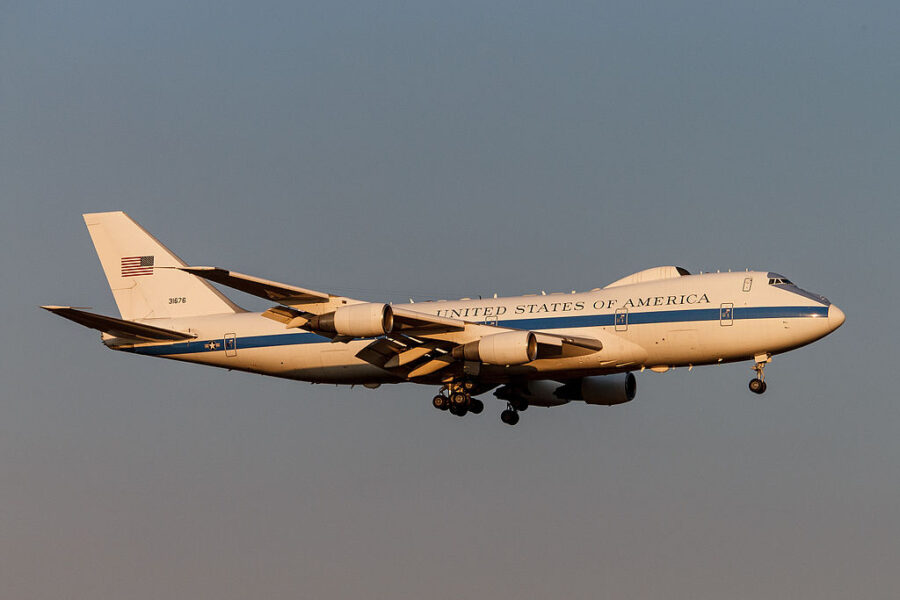Who Will Win U.S. Air Force’s E-4B Nightwatch ‘Doomsday Plane’ Competition?

The U.S. Air Force’s decision to exclude Boeing from the competition for a successor to the E-4B Nightwatch, commonly known as the “Doomsday Plane” for its nuclear war resilience, was confirmed by Boeing on Dec. 1. This move has significantly transformed the competition landscape.
Currently, privately-held defense contractor Sierra Nevada Corp stands as the lone public contender for the Survivable Airborne Operations Center (SAOC) contract, which aims to replace the existing fleet in service since the 1970s. While the Air Force plans to award the SAOC contract in 2024, details about other bids remain classified.
The SAOC program seeks to replace the Boeing E-4 Advanced Airborne Command Post (AACP) “Nightwatch” is a strategic command and control military aircraft operated by the United States Air Force (USAF). The E-4 series are specially modified from the Boeing 747-200B for the National Emergency Airborne Command Post (NEACP) program.
The E-4 serves as a survivable mobile command post for the National Command Authority, namely the President of the United States, the Secretary of Defense, and successors. The four E-4Bs are operated by the 1st Airborne Command and Control Squadron of the 595th Command and Control Group located at Offutt Air Force Base, near Omaha, Nebraska. The current E-4B fleet is aging and increasingly costly to maintain. The E-4B’s service life is expected to conclude in the early 2030s, making the SAOC contract a pivotal initiative for national security.
Sources familiar with the situation cited disputes between Boeing, the incumbent E-4B manufacturer, and the Air Force regarding data rights and contract terms. Boeing’s reluctance to commit to a fixed-price agreement that might exceed cost limits led to this outcome.
Boeing maintains confidence in its SAOC approach, highlighting its comprehensive, technically advanced, and low-risk solution. However, Boeing’s defense unit has encountered challenges in fixed-price development programs, resulting in substantial losses.
The Air Force aims to award the SAOC contract in Q2 2024, planning to procure two aircraft initially and a total of eight by 2030. The fiscal year 2024 budget allocates $889 million for the SAOC program, a significant increase from the previous fiscal year’s $98 million.
While SAOC requirements are classified, the Air Force has indicated the need for a large platform with four engines, similar to the E-4B, capable of flying up to 15,000 kilometers, accommodating up to 370 passengers, and featuring modern communication and satellite systems, as well as a modern kitchen.
Sierra Nevada Corporation (SNC), a privately-held defense contractor partnered with Lockheed Martin and Boeing, is the sole company publicly expressing interest in the SAOC contract. SNC has proposed a modified version of the Airbus A330-200, a twin-engine widebody aircraft with impressive range and passenger capacity.
SNC specializes in data and communication modifications to existing aircraft and has a significant track record of working with the Air Force, particularly with the Big Safari outfit at Wright-Patterson AFB in Ohio. Their new Dayton complex is designed to accommodate 747-8s, aligning with their expertise in post-production modifications of aircraft.
The Air Force has not disclosed other bids or commented on the matter, though speculation exists that Boeing may offer a 747-based solution, given the program’s allowance for modified used commercial aircraft. Boeing is concurrently developing the VC-25B, a new Air Force One based on the 747-8, potentially sharing commonalities with SAOC.
Despite being a dark horse in the competition, SNC is preparing to potentially more than double the Air Force’s existing fleet of four aircraft. While the SAOC program and its competitors are largely classified, it is known that SNC has selected aircraft for the program, focusing on quality and low life-cost for the SAOC program.
Sources: AirGuide Business airguide.info, thedrive.com, aviationweek.com, reuters.com
